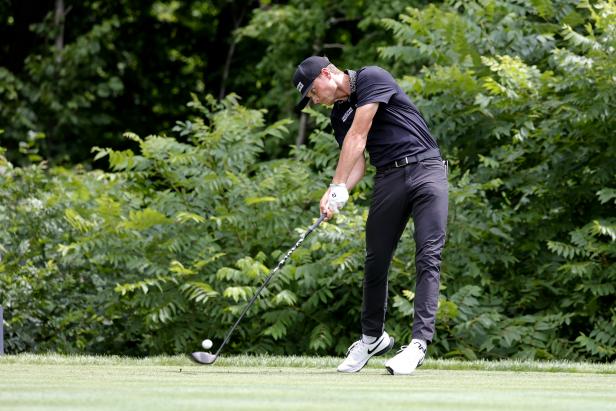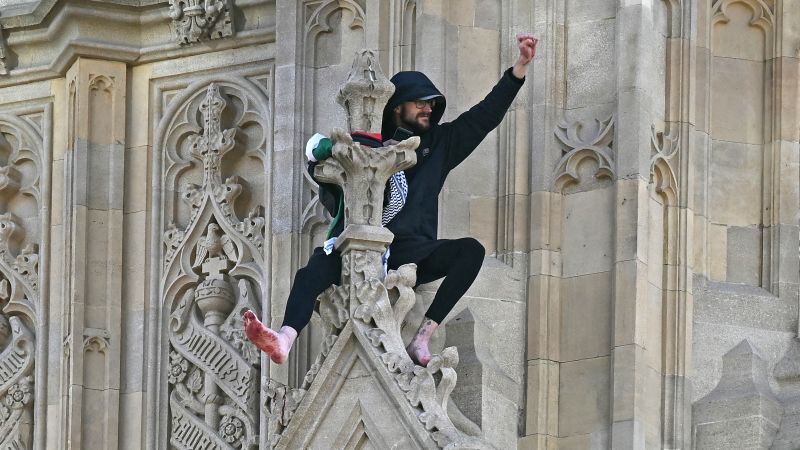The new ‘speed era’ is misunderstood. What golf’s next stars are really saying about distance

CHASKA, MINN. — First, there was the Bomb and Gouge era, which emerged as statistics proved the importance of driving distance. In turn, new technologies, fitness regimens and swing techniques allowed players to swing faster than ever.
Now, we’ve just entered a new age in golf—the Speed-Plus era—and we’re getting a glimpse of it during this week’s U.S. Amateur at Hazeltine National. Among the leaders of this new era are Gordon Sargent, the super-bomber and the world’s second-ranked amateur set to begin his senior year at Vanderbilt, and 6-foot-8 newly-turned-professional Christo Lamprecht, both of whom register ball speeds north of 190 miles per hour.
What makes this era different? For one, these leaders aren’t outliers. Nearly everyone in the field at the USGA’s oldest championship boasts speed—seemingly a prerequisite for success with the modern game and something they’ve been taught almost since they could start holding a club. What was once considered fast—say, 175 mph ball speed—is now barely average in the college ranks.
But this new generation is misunderstood. If the Bomb and Gouge era of the past decade was all about maximizing driving distance at whatever cost, this new Speed-Plus era is more thoroughly informed by statistics, which concede that while distance is the most important factor to lowering your score, it comes with a point of diminishing returns. As it turns out, distance control and wedge play are emerging as the difference between a solid amateur and a standout tour player.
One leader in shifting this narrative on the analytics side is Scott Fawcett, who founded the course-management system DECADE Golf and works with numerous PGA Tour pros. Fawcett has long maintained that speed is the most important factor to lowering scores, but he acknowledges that the data is now showing a “speed boiling point” after which you get less benefit and would be better off working on your game in other areas, like wedge play.
“I’ve always said that about 190 to 195 mile-an-hour ball speed is the maximum usable ball speed to actually be any good at golf,” Fawcett says. “It’s a very fine line, even at 190. The kids are right. If they’re in that 182-185 range, that’s good enough.”
If the Bomb and Gouge era sought endless speed—think Bryson DeChambeau in 2020—Speed-Plus players recognize that distance has its limitations. In fact, if players get too long, which as Fawcett says is about 190 mph ball speed, “The shot pattern is just too wide. It’s just not functional on any golf course. Anything with any penalty hazards. The ball’s just in the air too long.”
Aside from being too difficult to control off the tee, the longest players also see decreased benefit when they find the fairway, according to Fawcett’s data. Citing strokes-gained creator Mark Broadie’s book “Every Shot Counts,” Fawcett explains that the difference in tour scoring average from the fairway at 180 yards vs. 140 yards is .17 shots. The difference in that same 40-yard margin when you go from 120 yards to 80 yards, however, is only a tenth of a shot. “I’d rather you be 80 yards away than 120, but it’s also not that big of a deal,” he says.
The Speed-Plus generation is embracing this strategy, not only because they buy into the analytics, but because many of them have seen it in practice, playing alongside tour pros in PGA Tour events. One guy who has watched plenty of the best players in recent months is Luke Clanton, No. 1 in the most recent World Amateur Golf Ranking, who has recorded three top-10 finishes on the PGA Tour this season. Clanton acknowledges that while he trained for speed when he was 16 or 17, as he has matured and played more demanding courses, like this week at Hazeltine National, he has shifted his strategy to account for more precision.
“I played with Scottie [Scheffler] in a practice round at Pinehurst,” says Clanton, whose hopes of winning the Havemeyer Trophy were dashed after a loss to Illinois All-American Jackson Buchanan in the second round. “On the first hole he hits this feathery pitching wedge to a front right pin, and I’m like, that’s the difference.
“It just shows you how quickly the difference between amateur golf and pro golf is just the wedges and putting. It’s the biggest thing for sure.”
Palmer Jackson, the Pittsburgh native who has been ranked as high as 36th in WAGR, said he chose to go back to Notre Dame for a fifth season of college golf last year specifically to improve with his shorter clubs.
“What I learned over five years [of college golf] is that there’s a lot of guys that have speed,” says Jackson, who made it to match play at Hazeltine before losing in the first round. “There are not a lot of guys that have incredible wedge play. I think that’s what separates good from great out here and the same thing on tour.”
Another player who echoes a similar sentiment is Duke rising senior Luke Sample, a semifinalist last month at the British Amateur who made it to the Round of 64 at Hazeltine.
“Speed’s definitely something that’s been part of my training over the years,” he says. “It comes and goes. Recently I haven’t spent as much time working on speed and more just trying to build a strong golf swing that can hold up and under pressure.”
If all this makes it seem like the next generation has had enough of the race for speed, not so. Each of the three players mentioned are longer than most, can top out 120-plus mph of clubhead speed and reach more than 180 mph of ball speed. So where does that leave those players who may not already have above-average length?
Bryan Kim, who won the 2023 U.S. Junior Amateur and competed in the 2024 U.S. Open, feels like he’s about in the middle of the pack with averaging low 170s ball speed. With that in mind, he works on speed training by “loading my right side a little more” and “hitting balls as hard as I can.”
Ratchanon “TK” Chantananuwat won an Asian Tour event at 15, was a semifinalist at the 2023 British Amateur and will be a freshman at Stanford this fall. Having played on the Asian Tour, DP World Tour and LIV Golf, Chantananuwat sees reason to get longer.
“I’m at the point where I don’t necessarily struggle, but I could definitely use more [speed],” he says. “On the Asian tour, I’m definitely at least average, if not above average. But then when I go out and play against the LIV guys, some of them like Matt Wolff, he was out driving me by 40 [yards], comfortably. That’s not OK. I’m definitely trying to build speed.”
Put simply, Kim and Chantananuwat are still trying to reach the speed boiling point. “If you’re in your mid-20s and want a long career and you’re 170 ball speed, you need to find some speed quickly,” Fawcett says.
But, again, even for these average-length players, it’s not a reckless pursuit of speed at all costs. At Pinehurst, Kim noticed that while college players might be longer than tour pros, the professionals have a tighter command over their shots. It’s why when Chantananuwat trains for speed, he does so while protecting his mechanics.
“You have to make sure your swing is correct at all times when you’re doing it so you’re increasing your speed responsibly,” he says. “That’s the only way you can swing faster without damaging the swing.”
Fawcett also agrees with this cautious approach and cites one of his clients who nearly won on the PGA Tour last week, Max Greyserman, who has picked up 10-20 yards in recent years by doing speed training the right way. Accordign to Fawcett, Greyserman takes 10 balls a few times a week and hits them as hard as he possibly can. Then, he’ll hit two “cruiser” shots with a smooth pace. Instead of smashing balls for hours, Greyserman limits his speed training, which helps him not only get more out of it, but it keeps his technique intact.
Because as Fawcett describes and as players at the U.S. Amateur understand, once you reach the speed boiling point, the focus then turns to precision with shorter clubs. Speed first, then distance control. Dustin Johnson is perhaps the clearest example in recent years of a guy who long had speed but reached major championship heights in 2016 not by getting longer, but by finding command of the shorter clubs.
“I was watching DJ hit balls at the Byron Nelson a couple of years ago, and he’s got a GC Quad and a Trackman set up and he’s got an alignment rod sitting behind him, stuck in the ground with a towel, and he’s going over and cleaning the face off after every single shot,” Fawcett says. “There’s just little nuanced things like that. All the best players just understand these tiny little things that tighten up spin rates, distance control, everything.”
Statistics isn’t the only factor shaping the Speed-Plus generation’s approach. Improved college practice facilities, many of which now have top-of-the-line launch monitors, dozens of targets and the ability for players to practice with the same premium brand balls they use in competition have all allowed players to sharpen their shorter clubs better than any previous generation.
All of this is what makes the Speed-Plus generation so compelling, even if to this point, they have been largely misunderstood. This is a speed-minded era, yes, but players also have a certain artificial wisdom that usually only comes after years of professional mediocrity, marred by poor wedge play. For that, they have analytics experts like Fawcett, Lou Stagner and Mark Broadie to thank.
As one feathery Scottie Scheffler short-iron dropping pin high proved to Clanton, and as the statistics confirm to others, “That’s the difference.”
Related
5 Things I Never Play Golf Without: David Dusek
Our 11-handicap equipment writer always brings his favorite divot repair tool, a portable speaker and some high-tech gear to the course.As long as the weather i
Donald Trump’s golf course wrecked by pro-Palestine protesters
Pro-Palestinian protesters have vandalized parts of U.S. President Donald Trump's golf course in Scotland in response to his proposal for the reconstruction of
Man holding Palestinian flag scales London’s Big Ben hours after…
CNN — Emergency services were called to London’s Palace of Westminster on Saturday a
EPD: Drunk driver parked car on golf course
EVANSVILLE, Ind. (WFIE) - Evansville police say they arrested a man after finding him drunk in his car that was parked on a golf course.Officers say they were c











